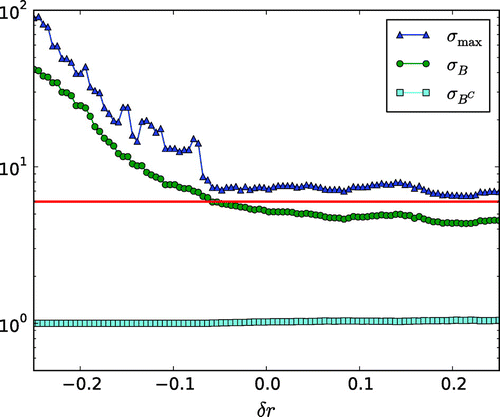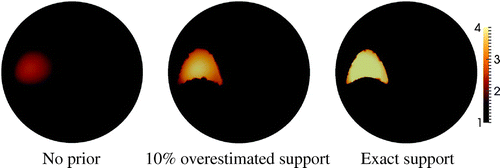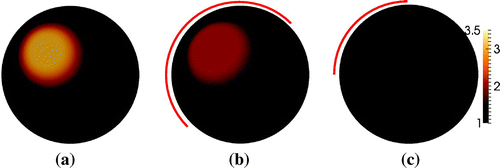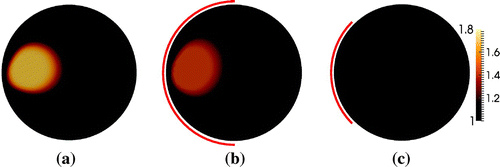Figures & data
Figure 1. (a) Phantom with kite-shaped piecewise constant inclusion . (b) Reconstruction of
using monotonicity relations from the approach in [Citation45] by use of simulated noiseless data.
![Figure 1. (a) Phantom with kite-shaped piecewise constant inclusion δσ. (b) Reconstruction of ∗suppδσ using monotonicity relations from the approach in [Citation45] by use of simulated noiseless data.](/cms/asset/e2994832-b434-4b0b-a935-b34a2ec79b19/gipe_a_1047365_f0001_oc.gif)
Figure 2. Numerical phantoms. (a) Circular piecewise constant inclusion. (b) Kite-shaped piecewise constant inclusion. (c) Multiple inclusions.

Figure 3. Full data sparse reconstruction of the phantoms in Figure without prior information on the support of inclusions.

Figure 4. Left: Dirichlet data corresponding to for the phantom in Figure (a), with 10% and 50% noise level. Middle: full data reconstruction for 10% noise level. Right: full data reconstruction for 50% noise level.

Figure 5. Full data sparse reconstruction of the phantom in Figure (a) varying the assumed support given by a dilation . The colour bar is truncated at
. For
, the contrast in the reconstruction is higher than in the phantom.
![Figure 5. Full data sparse reconstruction of the phantom in Figure 2(a) varying the assumed support given by a dilation δr. The colour bar is truncated at [1,6]. For δr<0, the contrast in the reconstruction is higher than in the phantom.](/cms/asset/b3e0573d-31ce-413a-9f0b-f034c8e18ca1/gipe_a_1047365_f0005_oc.gif)
Figure 6. Behaviour of full data sparsity reconstruction based on the phantom in Figure (a) by varying characterizing the assumed support. The correct support of the inclusion is a ball
while the assumed support is
.
is the average of reconstruction
over
and
is the average on the complement of
.
is the maximum of
on the mesh nodes.

Figure 7. Full data sparse reconstruction of the phantom in Figure (b). The applied prior information for the overestimated support is a 10% dilation of the correct shape.

Figure 9. Sparse reconstruction of the phantom with a ball inclusion in Figure (a). (a) 50% boundary data, no prior. (b): 50% boundary data with 5% overestimated support. (c): 25% boundary data, no prior. (d): 25% boundary data with 5% overestimated support.

Figure 10. Sparse reconstruction of the phantom with a kite-shaped inclusion in Figure (b). (a) 50% boundary data, no prior. (b) 50% boundary data with 10% overestimated support. (c) 25% boundary data, no prior. (d) 25% boundary data with 10% overestimated support.

Figure 11. TV reconstruction of the phantom with a ball inclusion in Figure (a). (a) Full boundary data. (b) 50% boundary data. (c) 25% boundary data.

Figure 12. TV reconstruction of the phantom with a kite-shaped inclusion in Figure (b). (a) Full boundary data. (b) 50% boundary data. (c) 25% boundary data.


